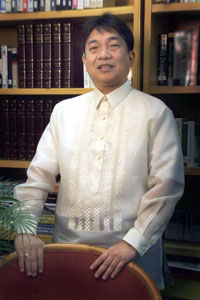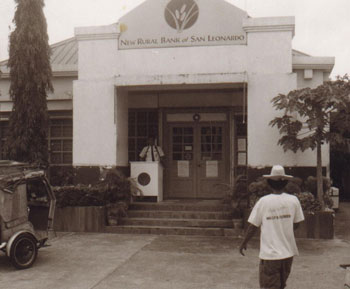About Us
Brief History and Background of New Rural Bank of San Leonardo (N.E.), Inc.
NRBSL commenced operation in June 06, 1994 under the authority of BSP Monetary Board Resolution No. 501 (11 June 1993). With a mere P3M initial capitalization and backed by a financing agreement with a partner organization in the Netherlands, the Bank was conceived and operationalized as a development finance institution organized by a group of civil society personalities, departing from the typical family-owned RBs. Led by its founding President and CEO Andres G. Panganiban, a former executive of various financial institutions local and overseas including the prestigious Chase-Manhattan Bank, they chose the once sleepy town of San Leonardo in the agricultural heart land of Nueva Ecija as the seedbed of its advocacy with a determination to prove that “banking with the poor, need not be poor banking”. NRBSL pioneered the modern-day micro-finance operations in the province through its iconic “Lima Para sa Lahat” Program” as immortalized in Mr. Panganiban’s book “Barefoot Banking”. In the succeeding years, the Bank redefined its market niche in servicing small farming communities through on-boarding with government’s credit program and pushed the transformation of micro-enterprises to SME status. Under its current leadership NRBSL has remained an accredited financial institution under Agri-Agra Law and has integrated supply chain as its innovative financing framework to help agricultural producers and rural entrepreneurs access affordable resource market and benefit from fair trade thus adding value to their commodities and increasing their competitiveness. In the coming years, NRBSL is transitioning to sustainable finance for its environment and social objectves.
Interview with Andres G. Panganiban
Where did your unconventional concept of banking originate?
 When I was young, I wanted to be a doctor. But I came from a family of businessmen, and my father told me: "Don't! Get into business".
When I was young, I wanted to be a doctor. But I came from a family of businessmen, and my father told me: "Don't! Get into business".
I grew up in Malabon (a suburb of Metro Manila) and I have fond memories of my childhood. In summer, I'd go to the river with my playmates, swimming and fishing. We would sometimes catch small crabs, or help drain nearby fishponds, or pick the fruits off the mansanitas tree.
In Malabon then, everyone was my friend. We'd sometimes fight over who won in tex card games. Sometimes, one would remark, "you're lucky, Boy, you have a good life." But our being from different social strata was not enough to affect our friendship.
I was the youngest in a brood of twelve, that's why I was called "Boy". Our eldest sister, who used to be a public school teacher, had the greatest business acumen in the family. Very early at dawn, she would look at the market and the market vendors. Sometimes, the market vendors would approach her for a loan, and she saw that lending to the vendors was lucrative business. Pretty soon, my father gave her the capital to go on.
I used to go with my sister to Balintawak, Divisoria, Nepa Q-mart, anywhere. We would collect lots of small amounts, sometimes in loose change. I'll never forget how the vendors would be so elated when we came. Not a day would pass when someone would thank her for a loan given. I told myself, "She's helping a lot of people".
During my high school and college days, I was an active student, and I enjoyed philosophy, which had a profound influence on me.
After I graduated in college, I already had a clear vision that I would go out into the world not just to enrich myself; probably because even at an early age, my vision was already different.
When did you venture into banking?
I've been a banker since 1976. I was working then for Chase Manhattan Bank, moving in the world of multinationals. I was always being sent to Singapore, Hongkong, New York, and London. I learned a lot at Chase, and I'll always be grateful for this. At Chase, I learned all the rudiments of banking, and I will never be lost even in its most complex maze.
But I saw that while going up the multinational corporate ladder, the color of my skin is taking on its Caucasian counterparts. Moreover, I was beginning to get bored. I got tired of having breakfast, lunch, or dinner with people I'd rather not have breakfast, lunch, or dinner with. I could not get over the corporate culture of mixing a business meeting with lunch. Part of my job description then was breakfast, cocktails, or dinner with a client that you wanted to close a deal with. Even on Saturdays and Sundays. If you need to learn golf, you have to. I felt I was selling my soul to the corporation.
In 1983, when Ninoy Aquino died, I told myself this is it! I was based in Makati at that time, and all I was doing from morning till afternoon was tear the pages of the office telephone directory, wait for the rallyists, and shower them with confetti.
At work, I felt I knew everything there was to know about banking and I was through with Chase. I was ripe for the picking. Time to move on. I wanted to use whatever knowledge I gained to help the poor. So I left Chase.
The problem is, my family did not believe in me. To them, I would always be the youngest child. I told them: "I want to go into business". And they told me: "You're a technocrat, what do you know about business?" They also chided me: "You'll end up giving everything you've got to the poor".
They can read me like a book. They were afraid that after giving me a few million pesos, I would just give them all away. They told me: "Business is business. This is not a church, nor a charity. Blood, sweat, and tears, went into this".
So when I left Chase, I went into NGOs. But then again, no NGO wanted to put up a bank. The perception then was, banks were anti-poor. Nobody understood what I wanted to do. I could not attract investors to put up capital for what I envisioned.
 Around 1990, I met some fellow development workers who also believed that the time is ripe. A paradigm shift was evolving then about development work. There were five of us, and we all agreed to put up a bank for the poor.
Around 1990, I met some fellow development workers who also believed that the time is ripe. A paradigm shift was evolving then about development work. There were five of us, and we all agreed to put up a bank for the poor.
But everybody we talked to was wary of the novelty. We tried borrowing from 4 or 5 funding agencies; they all declined. Either they did not understand or they lost touch of priorities. Finally, one agency, ICCO, saw the merits of our proposal. Probably, ICCO was already thinking that its aids and grants should not always take the form of dole-outs, but could take the form of income-generating loans. Our ideas collided, so to speak.
How did you start?
First, we conducted a feasibility study and presented the results at a conference in Baguio City. ICCO liked the idea. For the first time, they were convinced to grant a loan that will be used to put up a small bank for the poor here in the Philippines.
All at once, we knew we would put up a rural bank since it requires a small capital. If you will put up a universal bank, you would need billions of pesos. But we needed only three million pesos to open a rural bank. But the most important reason is, a rural bank is in the provinces, and the people we wanted to serve, the poorest of the poor, are usually in the provinces' littlest barrios.
What we envisioned to put up was not an ordinary rural bank, but a rural bank of wider, nationwide scope and perspective.
But back in 1992, the Central Bank did not allow the putting up of a rural bank in a town where another RB was already existing. Initially, we looked for sites near Manila as I live in the city. We went from Manila, to Bulacan, to Cavite. Alas! All the towns I went to already had a rural bank operating there. We were moving farther and farther from Manila.
 Until we reached Nueva Ecija.
Until we reached Nueva Ecija.
I knew I have relatives in Nueva Ecija but I didn't even know who they were. We were first eyeing the town of Talavera, but even there somebody already beat us into putting up a rural bank.
One of my teammates suggested we checked out San Leonardo. And so we went there. What greeted us was the town cemetery and I asked myself, "what kind of a town greets visitors and tourists with its cemetery?
But San Leonardo happened to be the first town nearest Manila without a rural bank, so we decided; even if we had to put up the bank atop a grave.
(I knew that we could put up branches in other towns. What was important was to find a place where the physical edifice can be erected to suit the requirements of the Central Bank, and so we can officially call ourselves a BANK).
On we went. It was the onset of the rainy season then. We went from house to house in San Leonardo, going barefoot into the mud to reach out to the people. For two months, we combed the barrios, talking to everyone, from snotty-nosed kids to legitimate businessmen. Not long after, we started calling ourselves the barefoot bankers.
